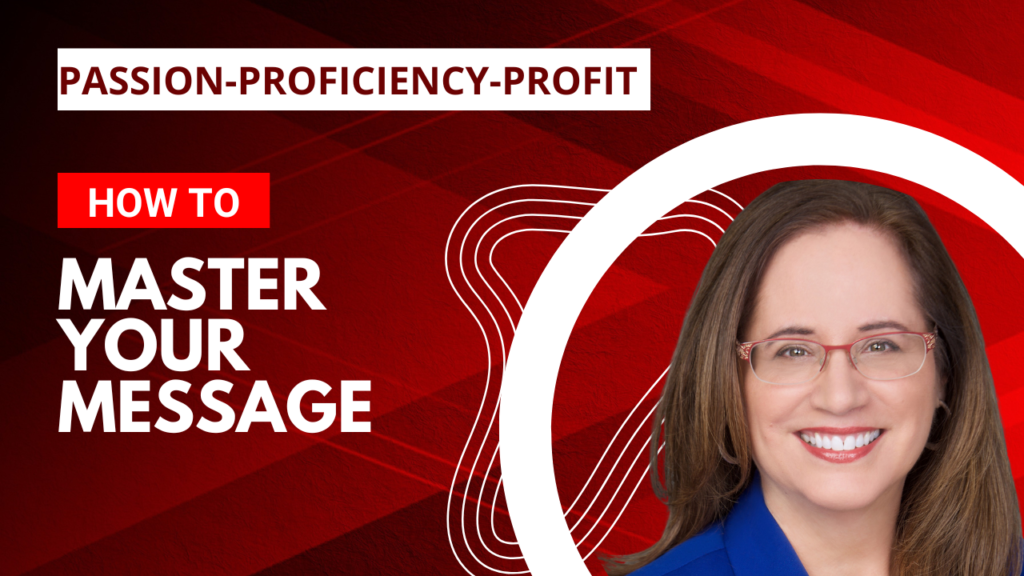Can you imagine yourself speaking with passion, speaking to an engaged audience, and possibly even getting paid to speak?
You can do all that and more when you master your message.
Watch the video, or read more below!
I’m not talking about exactly creating the message, although that’s important. I’m also not talking about how to tell a great story. Also very important. Nor am I talking about how to deliver with greater confidence. Again, very important. I’m talking about something even more foundational, and that’s getting really clear on your message, your audience, and your topic.
Topic Selection
Let’s get started with your topic and the three P’s: Passion, Proficiency, and Profitability. Ideally, your passion, proficiency, and profitability will all come together so that you have a topic that’s right in the sweet spot.
Passion
The first P that you need when you consider possible topics is passion. It has to be something you are passionate about. If you pick a topic you’re not excited about, that’ll come across to your audience, who won’t be excited either.
What do you love to do? To learn? To talk about, to teach, to spend time or money on? Consider your talents and your childhood passions. You may have to dig a little bit deep
Proficiency
You need to talk about something that you know, something that you have experience with.
Consider your personal experiences, life experiences, professional experiences, education and training skills, talents, hobbies, and desire and ability to learn. You may ultimately talk about something that you may not have a lot of proficiency with right now, but maybe you have such a passion for learning about it that it becomes a proficiency for you.
Profitability
Profitability as a speaker doesn’t always mean getting paid to speak. It might mean that you speak for free, but you use speaking as lead generation for your business. You might speak to a group for free, but then they sign up for something that generates income for you. If you’re speaking for work, you might get a promotion. If you’re speaking for a nonprofit, maybe you’ll speak on a hot topic that will gain donations for your nonprofit. Profitability can happen in a lot of ways.
The topic you pick does matter. You have to think about who’s going to hire you now. Some Evergreen topics will always be in demand, and some are trending topics. Sometimes you can combine them. A few Evergreen topics: creativity and innovation, change management, leadership, communication, maximizing performance, and sales and marketing. A few trending topics: DEI (diversity, equity, and inclusion), digital transformation (artificial intelligence, online commerce, online sales), health and wellness (dealing with stress, meditation, mindfulness, holistic health, spirituality, mental health, and safety at work) global topics, the circular economy/sustainability, and the future of work.
I have a client who is working on her second keynote with me. She is a leadership coach who speaks on leadership to human resource professionals. She combined the Evergreen topic of leadership with a trending topic and came up with this keynote title: “The Future of Work: Building the Next Generation of Leaders.”
What is your “sweet spot” topic?
Your Ideal Audience
Think about who your ideal audience is. Sometimes you can even picture just one person and let that be the audience that you design for.
· What is the age range?
· The male-to-female ratio?
· Job responsibilities or personal responsibilities?
· Biggest pain points?
· Why would they care about your topic?
· What do they expect?
For example, for my topics on communication skills, the age range is typically about 30 to 60, with some clients older, some clients younger. The male-to-female ratio is about even. My clients typically are professionals, often in technical fields, but in all fields. Sometimes I have entrepreneurs who want to speak to build their business or to pitch to investors. What are their biggest pain points? Confidence is the biggest pain point. And then clarity, making sure they’re clear on their message and engaging. Why would they care? Well, their business or their profession demands that they get better. What do they expect they expect? Pretty prescriptive coaching where I give them skills to work on and provide accountability.
So what is your ideal audience?
Think-Feel-Do Outcomes
What do you want your audience to think, feel, or do at the end of your presentation? Begin with the end in mind. What do you want them to think? What do you want them to feel? And when it comes to do, I suggest just one action. What do you want them to do next?
For example, let’s say I am a college professor, and my audience is college students. The topic would be presentation skills. Think, Feel, Do: I want the students to think, “I can speak with confidence.” I want them to feel excited to present– not so much nervous, but excited. And what I want them to do is to speak on a topic of high interest at the next class. My one-sentence message, which I may never say in the presentation, is: Learning powerful public speaking skills will give you the confidence to voice your message. And to change your world.
What is YOUR think, feel, do?
Hopefully, you can imagine yourself speaking passionately to an engaged audience. And getting paid to speak. I hope you’re more excited about your possible topic and audience. And if you’re ready to take the next baby step, schedule a complimentary session with me to discuss your message and goals.

